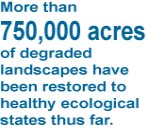Restore New Mexico
Restore New Mexico is an aggressive partnership launched in 2005 to restore our state’s grasslands, woodlands and riparian areas to a healthy and productive condition.
 The effort is becoming a great success! More than 750,000 acres of degraded landscapes have been restored to healthy ecological states thus far. ‘Restore’ partners will reach a goal of one million acres restored by the year 2010 – but there are millions more acres of land in need of renewal.
The effort is becoming a great success! More than 750,000 acres of degraded landscapes have been restored to healthy ecological states thus far. ‘Restore’ partners will reach a goal of one million acres restored by the year 2010 – but there are millions more acres of land in need of renewal.
What’s the big deal here? Is there something wrong with our landscapes today?
In many areas, historic overuse of the land has transformed fragile desert grasslands and open woodlands into virtual wastelands of creosote and mesquite, and diverse streamside vegetation into barren monocultures of salt cedar. These gradual changes have greatly damaged the land’s biological productivity, resulting in less wildlife, degraded water quality and decreased supplies of groundwater.
Restore New Mexico is focusing on large-scale restoration efforts on federal, state and private lands, targeting invasive and exotic brush species, including mesquite, juniper, creosote, cheatgrass and salt cedar. Add a little rain after treatments are applied and the land heals quickly!
The effort is truly historic, thanks to some significant opportunities that have arisen in the last four years. The BLM is working with state and federal agencies, ranchers and other landowners, conservation groups, local governments and other partners to cook up something big:
- Creosote and mesquite deserts are being replaced with healthy grasslands that can support much bigger populations of antelope and deer.
- Salt cedar is being removed from streams to restore our state’s iconic cottonwood-willow forests, recreating habitat for fish, birds and a host of other species.
- Overgrown woodlands are being restored to open savannas with abundant grasses and ‘browse species’ that beckon herds of mule deer and elk.
- Surface disturbance from historic oil and gas operations – from the time when there weren’t any requirements for surface reclamation – are being repaired, defragmenting (consolidating) wildlife habitat to benefit prairie chickens, sand dune lizards and other grassland-dependent species.
Restore New Mexico is much greater than the sum of its parts. It’s taking a vision and making it happen on the ground, to restore the landscapes that lift our spirits and define our character.
Won't you join us?